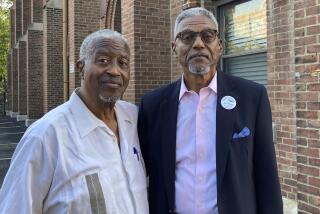Court to Hear Agent Orange Settlement Case
NEW ORLEANS — During an appendectomy in 1996, surgeons discovered that Vietnam veteran Joseph Isaacson had a form of cancer associated with exposure to the defoliant Agent Orange.
But when Isaacson tried to claim payment from a settlement fund set up by Agent Orange manufacturers, he was told he was too late and, besides, the $180-million kitty had been exhausted.
On Wednesday, the U.S. Supreme Court will hear arguments on whether Isaacson, a vice principal at a middle school in Irvington, N.J., and Daniel Stephenson, a retired helicopter pilot living in Florida, can sue the chemical companies that made Agent Orange.
“We want to see if we can reopen the case for all Agent Orange veterans who came down ill,” Isaacson said. “This is what this case is about.”
The chemical companies argue that a class-action settlement has ended their liability, and a corporate advocacy group says the case could threaten the finality of all class-action judgments.
A federal judge agreed, ruling that the men’s damage claims were preempted by a 1984 class-action settlement agreed to by Dow Chemical Co., Monsanto Co. and other companies that supplied Agent Orange to the military. The chemical was used in Vietnam to strip away the dense jungle foliage that provided cover for enemy forces.
The U.S. 2nd Circuit Court of Appeal reversed that ruling, setting up the Supreme Court hearing.
In 1984, neither Isaacson nor Stephenson was ill and could not claim to have been injured by Agent Orange.
Stephen Murray Jr., an attorney representing Stephenson, said the Supreme Court has held in previous cases that class-action settlements -- designed to handle huge numbers of similar damage claims -- do not preclude people from claiming damages for injuries that surface later.
“An individual who has yet to manifest any injury does not know if he has a valid claim,” Murray said.
Isaacson, 54, volunteered for the Air Force and served as a crew chief for an F-100 fighter jet in 1968 and 1969. Isaacson’s base was a depot for Agent Orange, and the flight line where he worked also was used by aircraft that sprayed the chemical, according to court records.
The appendectomy revealed he had non-Hodgkins lymphoma, which has been connected with Agent Orange exposure. Following chemotherapy, his cancer is in remission.
Stephenson served in Vietnam from 1965 to 1970 on the ground and as an Army helicopter pilot. In 1998, he was diagnosed with multiple myeloma, a bone marrow cancer, and underwent a bone marrow transplant.
Stephenson, like Isaacson, enjoyed good health before his cancer diagnosis and had a career as a civilian helicopter pilot, attorney Gerson Smoger said.
The companies set aside $180 million to compensate anyone injured by the end of 1994 and to pay for programs to benefit all veterans. Their attorneys argue that veterans who got sick after 1994 benefited from the programs the settlement funded.
More to Read
Inside the business of entertainment
The Wide Shot brings you news, analysis and insights on everything from streaming wars to production — and what it all means for the future.
You may occasionally receive promotional content from the Los Angeles Times.










